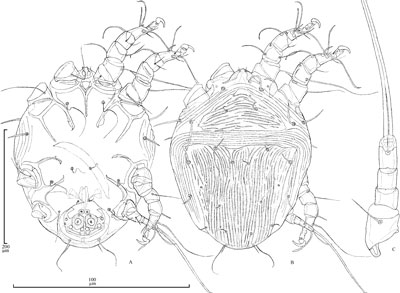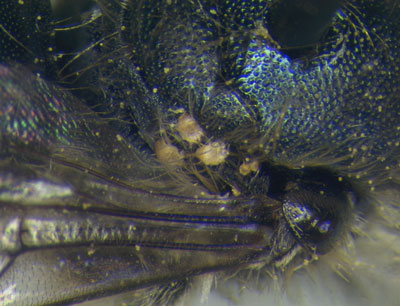Bee Mites :
Acari :
Acariformes :
Sarcoptiformes :
Chaetodactylidae : Chaetodactylus
Chaetodactylus rozeni Klimov and OConnor, 2008
?Chaetodactylus sp. Krombein, 1962: 248; Krombein, 1967: 310; Rust, 1974: 42.
Chaetodactylus micheneri Klimov and OConnor, 2008: 132, Fig. 65
Material (show database records) (USA). Holotype: HDN - North Carolina, Swain Co., Bryson City, apple flowers, ex Osmia georgica on 1st metasomal tergite & propodeum, 27 Apr 1923, J. C. Crawford 5464, AMNH 33827, BMOC 04-0508-007. Paratypes: 10 HDNs - same data as holotype; 3 HDNs - Texas, Montague Co., ?Montague (label reads: "Monteagle Texas"), ex O. georgica on propodeum, 16 Apr 1946, C. D. Michener, AMNH, BMOC 04-0508-009; 4 HDNs - Tennessee, Burrville, ex Chrysis coerulans (Hymenoptera: Chrysididae) on dorsal and ventral mesosoma, 24 May 1953, B. Benesh, CUIC, BMOC 78-0417-003. Holotype in AMNH, paratypes in AMNH, CUIC, UMMZ.
Identification. See key. Known form phoretic deutonymphs only.
Hosts. Osmia (Helicosmia) georgica (Megachilidae) (type host) (see also notes). Collected from Chrysis coerulans (Hymenoptera: Chrysididae), a polyxenous cleptoparasite of wasps and bees.
Distribution (show map). USA: North Carolina (type locality), Tennessee (see also notes), Texas.
Etymology. The new species is named after Jerome G. Rozen (AMNH), the renowned authority on bee biology and systematics.
Notes. Krombein (1962) reported heteromorphic deutonymphs of Chaetodactylus associated with Osmia caerulescens from New York. The deutonymphs were similar to those of Ch. krombeini except for having slightly but consistently shorter body setae (Krombein, 1962). Chaetodactylus rozeni has dorsal setae that are distinctly shorter than in Ch. krombeini, however, these two species also differ in many other morphological details. Because O. caerulescens and O. georgica belong to the same subgenus, Helicosmia, and their ranges are overlapping, we believe that Krombein (1962, 1967) probably dealt with mites identical with Ch. rozeni.
References
Klimov, P. B. & B. M. OConnor. 2008. Morphology, Evolution, and Host Associations of Bee-Associated Mites of the Family Chaetodactylidae (Acari: Astigmata), with a monographic revision of North American taxa. Miscellaneous Publications Museum of Zoology University of Michigan.199: 243.
Krombein, K. V. 1962. Natural history of Plummers Island, Maryland. XVI. Biological Notes on Chaetodactylus krombeini Baker, a parasitic mite of the megachilid bee, Osmia (Osmia) lignaria Say (Acarina, Chaetodactylidae). Proceedings of the Biological Society of Washington.75: 237-250.
Krombein, K. V. 1967. Trap-nesting wasps and bees: life histories, nests, and associates. Washington, D.C: Smithsonian press. 570 pp.
Rust, R. W. 1974. The systematics and biology of the genus Osmia, subgenera Osmia, Chalcosmia, and Cephalosmia (Hymenoptera: Megachilidae). Wasmann Journal of Biology.32: 1-93.
Image Gallery
B. OConnor and P. Klimov ©
Created: Mar 25, 2009
Last modified: 



